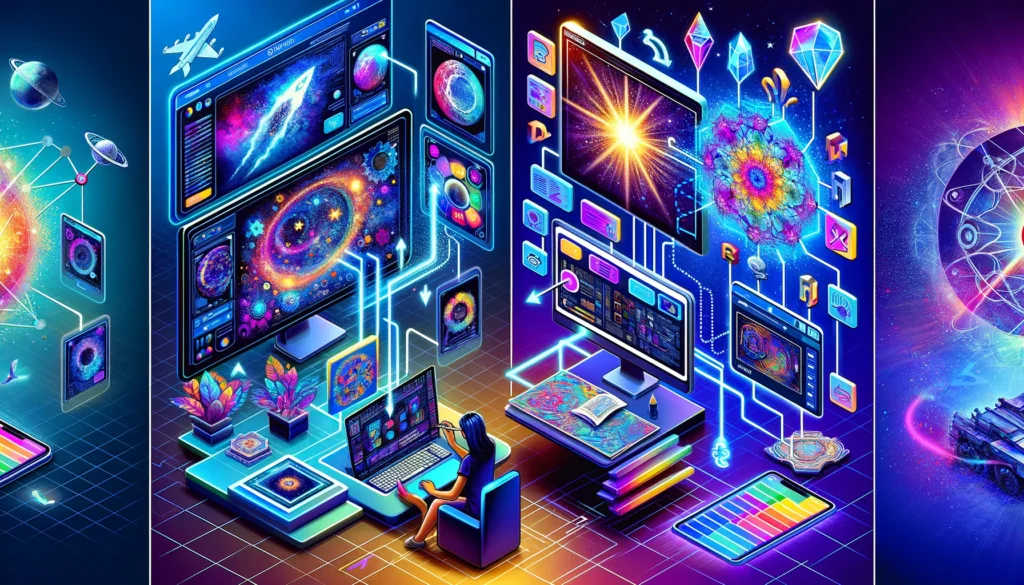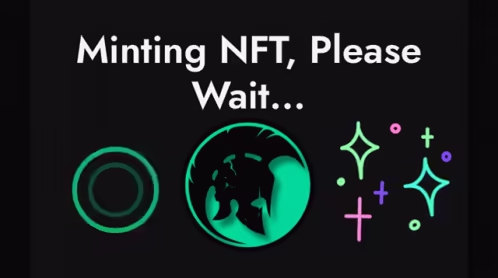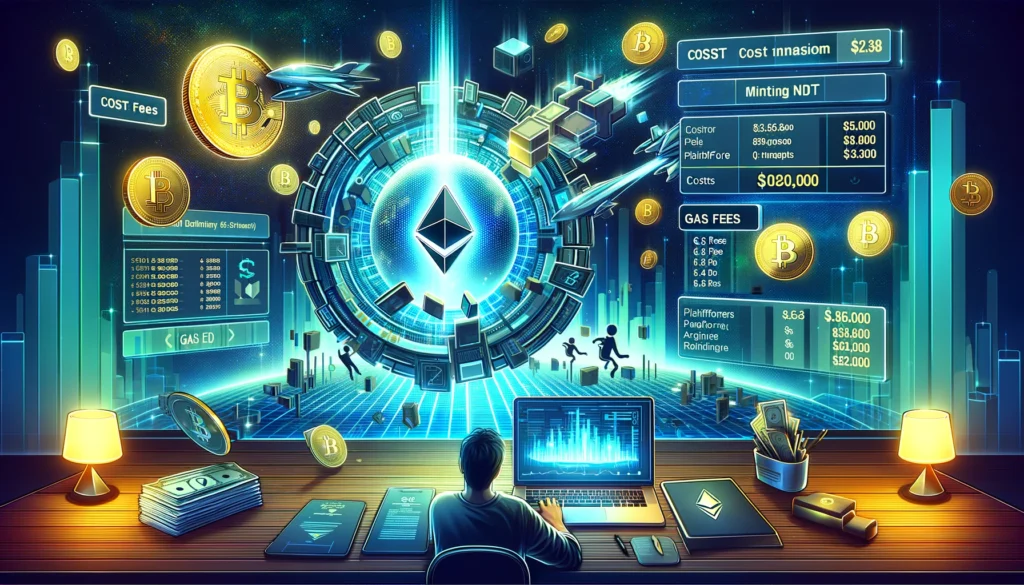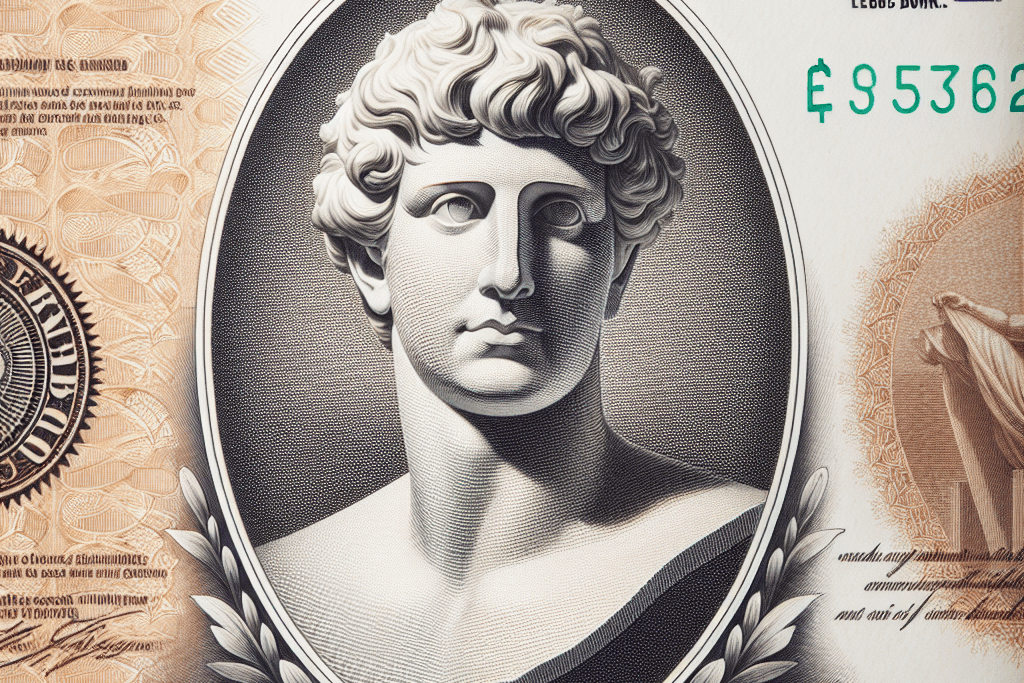NFTs, or Non-Fungible Tokens, have become very popular lately. If you want to understand more about NFTs, it’s important to know about minting. Minting NFTs is a key part of creating these digital assets. In this guide, you’ll learn what minting an NFT means and how it works.
Table of Contents
What is Minting NFT?
NFTs are unique digital items stored on a blockchain. They can be anything from art to music to in-game items. When you mint an NFT, you create a new token that represents a unique piece of digital content.
Minting is like creating a digital certificate of ownership. It tells everyone that you own that specific digital item.

How Does Minting NFT Work?
Minting an NFT involves a few simple steps. Here’s how it works:
- Choosing a Platform: First, you need to pick a platform where you will mint your NFT. Popular platforms include OpenSea, Rarible, Mintable, and Foundation. Each platform has its features, so choose the one that fits your needs best.
- Creating Digital Content: Next, create your digital content. This could be a piece of art, music, a video, or any digital creation that you want to turn into an NFT. Ensure that your content is unique and of high quality to attract potential buyers.
- Uploading the Content: Once your content is ready, upload it to the platform. This process is usually straightforward. You’ll need to fill in details like the title, description, and any other relevant information about your NFT.
- Paying the Minting Fee: Most platforms charge a fee to mint an NFT. This fee, often called a gas fee, is paid to the network for processing your transaction. The fee can vary based on network demand.
- Publishing the NFT: After paying the fee, your NFT is created and published on the blockchain. Now, it’s a unique digital asset that you own. You can sell, trade, or hold onto your NFT.
Minting an NFT is about creating, uploading, and paying a fee to publish your digital content on the blockchain. It’s a straightforward process that turns your digital work into a unique, ownable asset.
Platforms for Minting NFT
When you want to mint an NFT, choosing the right platform is crucial. Here are some popular platforms for minting NFTs:
- OpenSea: OpenSea is one of the largest NFT marketplaces. It supports a wide range of digital assets, including art, music, and collectibles. OpenSea is user-friendly, making it a great choice for beginners.
- Rarible: Rarible allows users to create and sell their own NFTs. It’s community-driven, meaning users can vote on platform upgrades. Rarible also offers the ability to set royalties, so creators can earn money every time their NFT is resold.
- Mintable: Mintable is known for its simple minting process. It offers two types of minting: gasless and traditional. Gasless minting allows users to create NFTs without upfront gas fees, which can be a cost-saving option.
- Foundation: Foundation is a platform focused on high-quality digital art. It’s invite-only, which helps maintain a high standard of artwork. Artists can earn significant profits, as the platform attracts serious collectors.
Here’s a quick comparison of these platforms:
| Platform | Key Features | Best For |
|---|---|---|
| OpenSea | Large marketplace, user-friendly | Beginners, diverse assets |
| Rarible | Community-driven, set royalties | Artists, creators |
| Mintable | Simple minting, gasless option | Cost-conscious users |
| Foundation | High-quality art, invite-only | Professional artists, collectors |
OpenSea Minting Process
Minting an NFT on OpenSea is straightforward. Here are the steps:
- Create an Account: First, you need to create an account on OpenSea.
- Connect Your Wallet: You need a digital wallet to store your NFTs. Connect it to your OpenSea account.
- Upload Your Content: Click on ‘Create’ and upload your digital content.
- Set Up Your NFT: Add details like the name, description, and any other information.
- Mint and Pay Fees: Pay the minting fee, and your NFT is live.
Advantages:
- Large user base
- Easy to use
- Supports various file formats
Disadvantages:
- High gas fees at times
Rarible Minting Process
Minting on Rarible is also simple:
- Create an Account: Sign up on Rarible.
- Connect Your Wallet: Link your digital wallet.
- Upload Your Content: Click ‘Create’ and upload your digital item.
- Set Up Your NFT: Add all necessary details.
- Mint and Pay Fees: Pay the required fees, and your NFT is created.
Advantages:
- User-friendly interface
- Allows setting royalties
Disadvantages:
- Can be pricey due to gas fees
Mintable Minting Process
Mintable is a popular platform for creating and selling NFTs, known for its simple and flexible minting options. Here’s how to mint an NFT on Mintable:
- Create an Account: Sign up on Mintable and create your account. You can link your digital wallet, such as MetaMask, to store your NFTs.
- Choose a Minting Option: Mintable offers two types of minting: gasless and traditional.
- Gasless Minting: This option allows you to create NFTs without paying upfront gas fees. The buyer pays the fee when purchasing the NFT.
- Traditional Minting: You pay the gas fee upfront to mint your NFT, which may speed up the listing process.
- Upload Your Content: Click on ‘Create New Item’ and upload your digital content. This can be anything from art, music, or even domain names.
- Set Details and Royalties: Add a title, description, and set the royalty percentage. Royalties let you earn a percentage of sales every time your NFT is resold.
- Mint Your NFT: If you choose traditional minting, you’ll need to pay the gas fee. Once done, your NFT is created and listed on Mintable’s marketplace.
Advantages:
- Gasless Minting: No upfront fees, which is great for cost-conscious creators.
- User-Friendly: Simple interface makes it easy to use.
Disadvantages:
- Gas Fees: Traditional minting can be expensive during high network demand.
Foundation Minting Process
Foundation is a high-end platform for digital art, known for its curated and invite-only community. Here’s how to mint an NFT on Foundation:
- Get an Invite: Foundation operates on an invite-only basis. You need an invitation from a current member to join the platform.
- Create an Account: Sign up on Foundation and connect your digital wallet, such as MetaMask. Your wallet will store your NFTs and handle transactions.
- Upload Your Art: Click on ‘Create’ and upload your digital artwork. Make sure your art is high-quality and meets Foundation’s standards.
- Set Details and Royalties: Provide a title, description, and set the royalty percentage. Royalties allow you to earn money from secondary sales.
- Mint and Pay Fees: Pay the gas fee to mint your NFT. Once minted, your NFT will be listed on Foundation’s marketplace.
Advantages:
- High-Quality Art: Foundation attracts serious collectors and maintains a high standard of artwork.
- Royalties: Set royalties to earn from future sales.
Disadvantages:
- Invite-Only: Limited access can be a barrier for new artists.
- Gas Fees: Minting fees can be high, especially during peak times.
Each platform has its own strengths. OpenSea offers a vast marketplace with easy navigation. Rarible provides control over royalties and a say in platform decisions. Mintable’s gasless option can save you money. Foundation focuses on high-quality art, attracting serious buyers.
Choosing the right platform depends on your needs. Consider factors like ease of use, costs, and the type of audience each platform attracts. This will help you find the best fit for minting your NFTs.
Costs Involved in Minting NFT

Minting an NFT comes with various costs. Understanding these costs can help you plan better. Here’s a breakdown of the main expenses:
- Minting Fees: This is the cost you pay to create an NFT. Minting fees vary depending on the platform you use. Some platforms offer gasless minting, which means you don’t pay upfront. Instead, the buyer covers the fee when they purchase your NFT.
- Gas Fees: Gas fees are charges you pay to process transactions on the blockchain. These fees can be high, especially on the Ethereum network, where most NFTs are created. Gas fees fluctuate based on network demand. During peak times, gas fees can be very expensive.
- Platform Fees: Some platforms charge additional fees for using their service. These fees might include a percentage of the sale price when your NFT is sold.
Here’s a comparison table of typical costs on different platforms:
| Platform | Minting Fee | Gas Fee | Platform Fee |
|---|---|---|---|
| OpenSea | Yes | High during peak times | 2.5% of sale price |
| Rarible | Yes | High during peak times | 2.5% of sale price |
| Mintable | Optional | High during peak times | 2.5% of sale price |
| Foundation | Yes | High during peak times | 15% of sale price |
Gas Fees Explained
Gas fees are payments made to miners who validate transactions on the blockchain. Here’s how they affect your costs:
- What are Gas Fees?: Gas fees are like transaction fees. They ensure your NFT is added to the blockchain.
- Impact on Minting Costs: High gas fees can significantly increase the cost of minting an NFT.
- Ways to Reduce Gas Fees:
- Mint during off-peak times when the network is less busy.
- Use Layer 2 solutions like Polygon to lower transaction costs.
Understanding these costs helps you make informed decisions about minting NFTs. By choosing the right platform and timing your minting, you can save on fees and make the process more affordable.
Benefits of Minting NFT
Minting NFTs has several benefits that attract artists, musicians, and other creators. Here are some key advantages:
- Ownership and Proof of Authenticity: When you mint an NFT, you create a unique digital certificate that proves ownership. This certificate is stored on the blockchain, making it secure and tamper-proof. This means you can verify who owns the NFT and trace its history. This is especially valuable for artists who want to protect their work from being copied or stolen.
- Potential for Earning Money: NFTs offer a new way for creators to make money. When you mint an NFT, you can sell it on various platforms. Depending on the demand for your work, NFTs can sell for significant amounts of money. Additionally, you can set up royalties to earn a percentage of sales every time your NFT is resold. This creates a continuous stream of income, rewarding creators for their ongoing popularity.
- Digital Permanence and Security: The blockchain technology behind NFTs ensures that your digital assets are permanent and secure. Once an NFT is minted, it cannot be altered or deleted. This permanence provides peace of mind for both creators and buyers. The decentralized nature of the blockchain also means there is no single point of failure, making it very secure against hacks and data loss.
- Global Reach: NFTs and blockchain technology are not limited by geographical boundaries. This means you can sell your NFTs to anyone around the world. Platforms like OpenSea and Rarible have global audiences, increasing the potential market for your digital creations.
- Community and Engagement: Many NFT platforms have vibrant communities where creators and collectors can interact. These communities provide support, feedback, and exposure, helping you grow your presence in the digital art world. Engaging with your audience can also lead to collaborations and new opportunities.
Comparison of Traditional Art vs. NFT Benefits
| Benefit | Traditional Art | NFTs |
|---|---|---|
| Ownership Proof | Physical certificates | Blockchain-based certificates |
| Earning Potential | One-time sales | Sales + royalties |
| Security | Prone to theft/damage | Blockchain security |
| Reach | Local/National | Global |
| Community Engagement | Limited to local galleries | Online global communities |
Minting NFTs offers unique benefits that are transforming how creators sell and protect their digital works. From ensuring ownership to providing continuous income, NFTs open up new possibilities for artists and other creators.
The security and global reach of blockchain technology further enhance these advantages, making NFTs a compelling option in the digital age.
Common Challenges in NFT Minting

Minting NFTs is an exciting process, but it comes with its challenges. Understanding these common issues can help you navigate the NFT world more smoothly. Here are some key challenges in NFT minting:
- High Gas Fees: One of the biggest hurdles in minting NFTs is the cost of gas fees. Gas fees are payments made to blockchain miners for processing transactions. These fees can fluctuate greatly, especially on the Ethereum network, where most NFTs are minted. High demand can cause gas fees to spike, making it expensive to mint NFTs. For example, during peak times, gas fees can exceed $100, adding a significant cost to your NFT creation.
- Environmental Concerns: Another major challenge is the environmental impact of minting NFTs. The process of validating and recording transactions on the blockchain requires a lot of energy. This has raised concerns about the carbon footprint of NFTs. Many artists and buyers are looking for more eco-friendly alternatives. Some solutions include using Layer 2 solutions or alternative blockchains like Tezos, which have lower energy consumption.
- Market Volatility: The NFT market is highly volatile. Prices for NFTs can vary widely, and what’s popular today might not be tomorrow. This makes it risky for both creators and buyers. For instance, an NFT that sells for thousands today could drop in value tomorrow. Staying informed about market trends and being cautious with investments is crucial.
- Intellectual Property Issues: There are also concerns about intellectual property rights. Since NFTs can be easily copied and sold, it’s important to ensure that you have the rights to the content you are minting. Misunderstanding or ignoring these rights can lead to legal issues. Always make sure you own the rights to your digital content before minting it as an NFT.
Comparison of Challenges
| Challenge | Description | Potential Solutions |
|---|---|---|
| High Gas Fees | Expensive transaction costs on Ethereum | Mint during off-peak times, use Layer 2 solutions |
| Environmental Concerns | High energy consumption of blockchain | Use eco-friendly blockchains like Tezos |
| Market Volatility | Fluctuating NFT prices | Stay informed, cautious investment |
| Intellectual Property Issues | Risk of copyright infringement | Ensure ownership of digital content |
Navigating these challenges requires awareness and strategic planning. By understanding the costs, environmental impacts, market risks, and legal aspects, you can make more informed decisions when minting and buying NFTs.
This will help you avoid common pitfalls and make the most of the opportunities in the NFT space.
How to Promote Your Minted NFT
Promoting your minted NFT is essential to attract buyers and make sales. Here are some effective ways to get your NFT noticed:
- Using Social Media: Social media platforms like Twitter, Instagram, and TikTok are great for promoting your NFTs. Post regularly about your work, share behind-the-scenes content, and engage with your audience. Use popular hashtags like #NFT, #CryptoArt, and #NFTCommunity to reach a broader audience.
- Collaborating with Influencers: Partnering with influencers in the NFT space can give your work a significant boost. Influencers have large followings and can introduce your NFTs to a wider audience. Reach out to influencers who share your style or focus and propose a collaboration.
- Participating in NFT Communities: Join NFT communities on platforms like Discord, Reddit, and Clubhouse. These communities are full of potential buyers and other creators who can offer support and advice. Participate in discussions, share your work, and attend virtual events to network and promote your NFTs.
Here’s a breakdown of how to use these methods effectively:
Promoting on Twitter(X)
Twitter is one of the most popular platforms for NFT promotion. Here’s how to make the most of it:
- Tweet Regularly: Post updates about your NFTs, including new releases and behind-the-scenes content.
- Engage with Followers: Reply to comments, retweet relevant content, and join Twitter Spaces discussions.
- Use Hashtags: Include hashtags like #NFT, #CryptoArt, and #NFTCommunity to increase visibility.
Promoting on Instagram
Instagram is perfect for visual content. Here’s how to use it effectively:
- Share High-Quality Images: Post pictures of your NFTs and use Instagram Stories to show the creation process.
- Engage with the Community: Comment on other artists’ posts, join relevant groups, and use hashtags like #NFTArt and #DigitalArt.
Using these strategies will help you reach a larger audience and increase the chances of selling your NFTs. Engaging with social media, collaborating with influencers, and being active in NFT communities are key steps to promote your NFTs effectively.
Remember, the more you interact with potential buyers and other creators, the more visibility your NFTs will get. This can lead to more sales and a stronger presence in the NFT market.
Frequently Asked Questions (FAQs)
What is the best platform to mint NFT?
Choosing the best platform to mint an NFT depends on your needs and goals. If you’re a beginner, OpenSea is an excellent choice because of its user-friendly interface and extensive resources that make the process straightforward.
For artists who want more control over royalties, Rarible is a great option. It allows you to set a percentage that you will earn each time your NFT is resold.
Mintable is another good platform, especially for those looking to avoid high upfront costs, as it offers a gasless minting option. Foundation is ideal for high-quality art and professional creators due to its invite-only system, ensuring a curated marketplace.
How much does it cost to mint an NFT?
The cost to mint an NFT can vary widely depending on the platform and current network fees, known as gas fees. Typically, minting fees can range from a few dollars to over $100. On the Ethereum blockchain, gas fees fluctuate based on network demand. During peak times, these fees can be quite high, significantly increasing the cost of minting an NFT. Some platforms, like Mintable, offer gasless minting options, where the buyer pays the gas fee upon purchase, which can help reduce upfront costs for creators.
Can you mint an NFT for free?
Yes, some platforms offer options to mint NFTs without upfront costs. This process is often called “lazy minting.” With lazy minting, the NFT is created and listed for sale, but the gas fee required to mint it is not paid until someone buys the NFT.
The buyer covers the gas fee at the time of purchase. Platforms like Mintable offer this feature, making it accessible for creators who want to avoid high upfront costs associated with traditional minting methods.
What is the difference between minting and buying an NFT?
Minting an NFT is the process of creating a new NFT from your digital content and registering it on the blockchain. This involves uploading the content, setting its details, and paying any required fees. Buying an NFT, on the other hand, means purchasing an NFT that someone else has already created and listed for sale. When you buy an NFT, you are acquiring ownership of that digital item from the current owner. Minting is about creation, while buying is about acquisition.
Is minting NFT profitable?
Minting NFTs can be profitable, but it depends on several factors, including the demand for your digital content, the quality and uniqueness of your work, and how well you promote your NFTs. Some creators have made significant money by selling their NFTs, especially if they build a strong following or create highly sought-after pieces.
However, the market is also volatile, and not all NFTs will sell or fetch high prices. Successful NFT creators often combine talent, marketing, and timing to maximize their profits.
How long does it take to mint an NFT?
The time it takes to mint an NFT can vary from a few minutes to several hours. This depends on the platform you are using and the current congestion of the blockchain network. On platforms like OpenSea or Rarible, the actual process of uploading your content and setting details is quick, usually taking just a few minutes.
However, the transaction needs to be confirmed on the blockchain, which can take longer during times of high network activity. Plan for some waiting time, especially during peak periods.
Can you mint multiple NFTs at once?
Yes, many platforms allow you to mint multiple NFTs in a single transaction. This process is often referred to as batch minting or bulk minting. It can save on gas fees, as you pay for a single transaction instead of multiple individual ones.
Platforms like OpenSea and Rarible offer batch minting options, making it easier and more cost-effective to create a series of NFTs at once. This is particularly useful for artists and creators who want to release a collection of works.
Do you need a digital wallet to mint an NFT?
Yes, a digital wallet is essential for minting and managing NFTs. A digital wallet stores your cryptocurrencies and NFTs securely. Popular wallets for NFT transactions include MetaMask, Coinbase Wallet, and Trust Wallet. These wallets allow you to interact with blockchain networks, pay for gas fees, and store your minted NFTs. Connecting your wallet to platforms like OpenSea, Rarible, or Mintable is a necessary step in the minting process, enabling you to handle transactions and manage your digital assets.
What file formats are supported for minting NFTs?
Most NFT platforms support a variety of file formats to cater to different types of digital content. Commonly supported formats include JPEG and PNG for images, GIF for animations, MP4 for videos, and MP3 for audio files. Each platform may have specific requirements or limitations regarding file size and type, so it’s important to check the guidelines of the platform you are using. Ensuring your content is in a supported format and meets the platform’s specifications is crucial for a smooth minting process.
How do royalties work for minted NFTs?
Royalties in the NFT world allow creators to earn a percentage of the sale price every time their NFT is resold. When you mint an NFT, you can set a royalty percentage, typically ranging from 5% to 10%. This means that each time the NFT is sold on a secondary market, you receive a portion of the sale price.
Platforms like Rarible and Foundation support royalty features, ensuring that artists continue to benefit from the increasing value of their work as it changes hands over time. This continuous earning potential makes royalties a significant advantage for NFT creators.
Final Thoughts: What is Minting NFT and How Does it Work
Minting NFTs is a fascinating process that lets you create unique digital assets. Understanding how it works can open new opportunities for creators and collectors alike. Whether you’re looking to mint your first NFT or just curious about the process, this guide covers the basics to get you started. Explore the platforms and tools available, and dive into the world of NFTs today.
